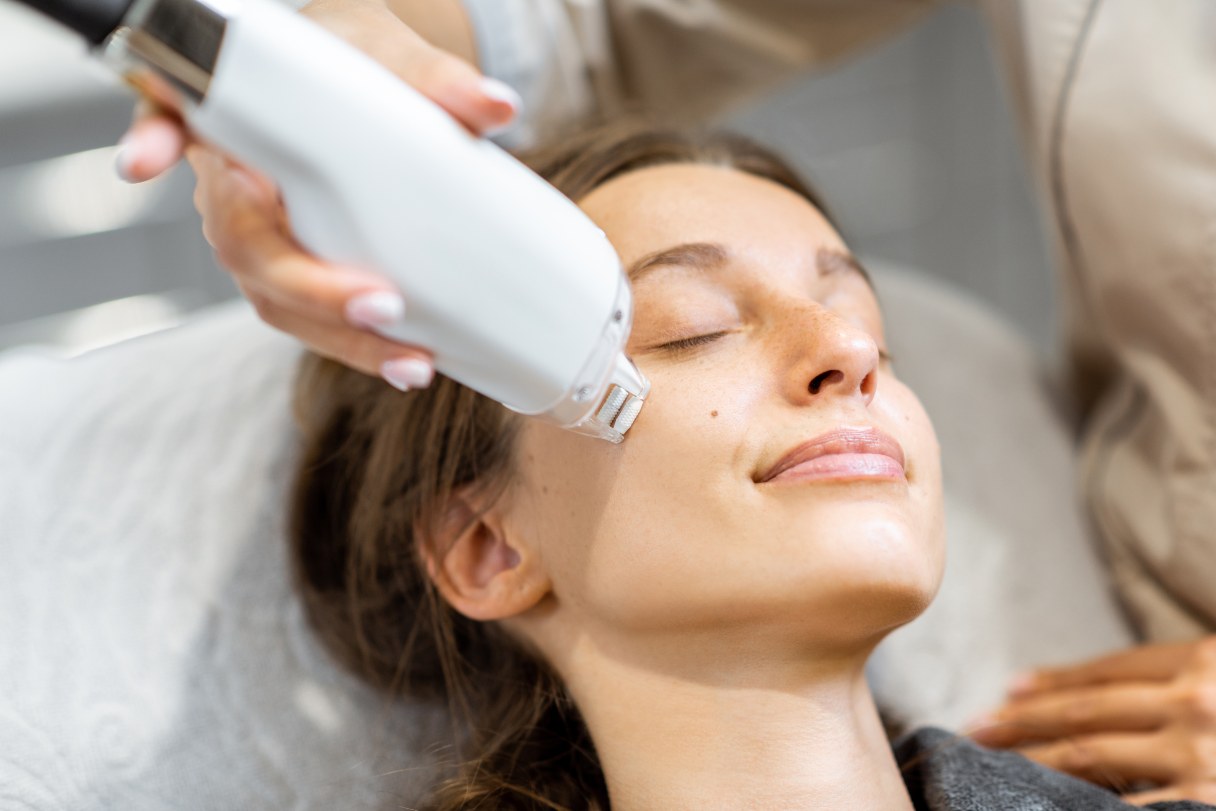If you have moles, you're not alone — almost every adult has at least a few of these skin growths. In fact, many adults have between 10 and 40 moles somewhere on their body. And while most moles are harmless, there are a few reasons you might consider getting yours removed.
Why Should Moles Be Removed?
Your doctor will recommend mole removal if they suspect a mole is cancerous. You may also choose mole removal for cosmetic reasons. If you develop new moles after age 30 or your moles are itchy or bleeding, see your doctor. As an adult, new moles or changes to existing moles can be a sign of an atypical mole or a melanoma.
Different Types of Moles
Wondering what kind of moles you have? There are three general types of moles: common moles, atypical moles and melanomas.
Common moles
These don't need to be removed unless they're bothering you — whether they're rubbing against your clothing or you just don't like the way they look. In most cases, this would be considered cosmetic mole removal.
Typical characteristics of common moles include:
- Less than 5 millimeters wide (about the size of a pencil eraser)
- Uniform color (pink, tan or brown)
- Round or oval
- Smooth surface with a distinct edge
- Dome-shaped
These benign moles are usually harmless and don't change much over time. However, people who have a lot of small moles or a few large ones may have a higher risk of developing melanoma.
Atypical moles
These are usually harmless, but your doctor may recommend removing them if they look suspicious. Atypical moles may also be removed for cosmetic reasons.
Typical characteristics of atypical moles include:
- More than 5 millimeters wide
- Mixture of several colors (from pink to dark brown)
- Flat to slightly raised
- Smooth, slightly scaly or pebbly surface
- Irregular edge that may fade into the surrounding skin
It's important to keep a close eye on atypical moles to ensure they don't change color, shape or size. If you have more than five atypical moles or a significant family history of skin cancer, your doctor may recommend you do monthly self-skin exams and to have a yearly skin exam because of a moderately increased likelihood of melanoma.
Melanomas
This is skin cancer, so it must be removed. When caught early, melanoma is highly treatable.
Typical characteristics of melanomas include "ABCDE" features:
- The shape of one half doesn't match the other (asymmetrical)
- Ragged, notched or blurred edges (irregular border) or bleeds easily
- Shades of black, brown and tan with areas of white, gray, red, pink or blue (uneven color)
- More than 6 millimeters wide (large diameter)
- Has changed over the past few weeks or months (evolving)
If you notice any moles that have these “ABCDE" features, visit your dermatologist to get tested for skin cancer. Melanoma is a type of skin cancer that can spread to other parts of the body, so the sooner it's detected and removed, the greater the likelihood that treatment will be successful.
How Much Does Mole Removal Cost?
The national average cost* of mole removal ranges between $116 to $1,033, depending on the technique your provider performs. The average cost* of surgical excision is $325, with a range of $251 to $583, depending on the size and location of the mole.1
Average cost of mole removal by procedure type
Below are the average costs* and cost ranges of the different types of mole removal:1
| Type of mole removal procedure | Average cost | Cost range |
|---|---|---|
| Surgical shaving | $151 | $116 to $288 |
| Surgical excision | $325 | $251 to $583 |
| Cryotherapy | $209 | $161 to $392 |
| Laser | $531 | $411 to $1,033 |
Average cost of mole removal by state/district
The cost of mole removal also varies according to where you live. Providers in major cities may charge more, while those in less in-demand neighborhoods may charge less.
Here is an overview of the average cost* for mole removal by surgical excision across all 50 states and the District of Columbia:1
| State/District | Average cost for surgical excision |
|---|---|
| Alabama | $274 |
| Alaska | $397 |
| Arizona | $328 |
| Arkansas | $288 |
| California | $401 |
| Colorado | $326 |
| Connecticut | $345 |
| Delaware | $324 |
| District of Columbia | $410 |
| Florida | $323 |
| Georgia | $298 |
| Hawaii | $463 |
| Idaho | $332 |
| Illinois | $318 |
| Indiana | $293 |
| Iowa | $277 |
| Kansas | $289 |
| Kentucky | $301 |
| Louisiana | $302 |
| Maine | $336 |
| Maryland | $376 |
| Massachusetts | $394 |
| Michigan | $296 |
| Minnesota | $306 |
| Mississippi | $291 |
| Missouri | $284 |
| Montana | $322 |
| Nebraska | $290 |
| Nevada | $327 |
| New Hampshire | $335 |
| New Jersey | $355 |
| New Mexico | $289 |
| New York | $338 |
| North Carolina | $306 |
| North Dakota | $298 |
| Ohio | $299 |
| Oklahoma | $277 |
| Oregon | $346 |
| Pennsylvania | $319 |
| Rhode Island | $350 |
| South Carolina | $303 |
| South Dakota | $294 |
| Tennessee | $289 |
| Texas | $301 |
| Utah | $330 |
| Vermont | $342 |
| Virginia | $319 |
| Washington | $367 |
| West Virginia | $292 |
| Wisconsin | $305 |
| Wyoming | $305 |
Additional mole removal cost considerations
As you consider mole removal, keep additional costs for biopsy and aftercare in mind.
- Biopsy. After removing your mole, your dermatologist will typically send the removed mole to a pathologist to determine if the mole is cancerous. This test can add a couple hundred dollars to your total cost. Confirm if it is included in the price you are quoted for the removal.
- Aftercare. You may need pain-relieving medication after your mole is removed, which is an additional expense. And if you need to get stitches removed, be sure to find out if that office visit is included in your up-front costs.
Is Mole Removal Covered by Insurance?
If you're having a common mole removed for cosmetic reasons, it most likely won't be covered by health insurance. Also, some plastic surgeons don't accept insurance, so be sure to ask about the doctor's policies before you make an appointment.
If the procedure is considered medically necessary, however, your mole removal and biopsy will most likely be covered by insurance, except for copays and deductibles. Check with your insurance provider to find out what kind of documentation you'll need to get the procedure approved.
How Does Mole Removal Work?
Mole removal is typically a quick outpatient procedure. Before a doctor removes a mole, they will clean the area with an antiseptic and inject it with an anesthetic. Once the area is numb, mole removal should be comfortable.
Next, the doctor will employ either surgical shaving, surgical excision, cryotherapy or laser techniques to remove the mole.
- Surgical shave. The doctor will use a razor blade to shave the mole to the level of the skin around it. They may also cauterize (lightly burn) the area around the mole to improve the appearance of any scarring after healing. Finally, they will apply petroleum jelly or antibiotic ointment and bandage the wound. Shaving is best for moles that don't go much deeper than the top layer of the skin.
- Surgical excision. The doctor will use a scalpel to separate the mole from the rest of your skin. They may also take a margin of healthy skin to ensure all the mole cells are removed. Then, they will use forceps to remove the mole. The doctor may cauterize the area to stop any bleeding before closing the wound with stitches and applying petroleum jelly. Excision is best for larger or deeper moles, and typically removes the entire mole.
- Cryotherapy. Frequently used for small, noncancerous moles, this technique utilizes liquid nitrogen to freeze the mole, eliminating the need for cutting or stitches.
- Laser removal. Focused light beams are used to break down mole cells, making it a popular choice for cosmetic mole removal, particularly for smaller, noncancerous moles.
Dermatologists can safely and easily remove a mole usually in just one or two office visits. Once the mole is removed, a pathology doctor will examine it under a microscope to determine if the mole is benign or if any cancer cells are present. If cancer is present, they can also determine if it has been completely removed.
After either procedure, you should be able to drive yourself home and return to work or school right away. Keep in mind that you may need a second appointment if your doctor needs to remove any leftover cells from a larger mole, or if a biopsy reveals that the surrounding tissue is abnormal.
Mole Removal Recovery: Tips and Timing
During the first few days after mole removal, you may experience some redness, itching, discomfort and discharge from the wound. If these symptoms worsen, call your doctor.
Be sure to clean the area daily, keep it moist with petroleum jelly or antibiotic ointment and change any bandages as instructed to promote healing and prevent infection. The stitches from a surgical excision will either dissolve or be removed by the doctor in about 10 to 14 days.
It takes about two to three weeks for the skin to heal from mole removal. Once the wound has healed, it can remain red for weeks to months after removal. Cover it with sunscreen when you're outside to help protect against pigmentary changes to the scar. You can expect a flat or slightly indented scar after surgical shaving, or a longer, linear scar after surgical excision.
Possible Side Effects of Mole Removal
In-office mole removal is a low-risk procedure. Still, possible concerns include:
- Uncontrolled bleeding
- Infection
- Bumps or discoloration
- Some type of scar is expected, but is typically less visible than the mole
- Mole recurrence
Call your doctor if you experience any of these side effects of mole removal. If your mole grows back, be sure to see your doctor right away, as this could be a sign of melanoma.
Do not remove a mole yourself
Never attempt to remove a mole yourself. None of the products sold for removing moles at home have been FDA-approved, and may cause the following:
- Infection
- Uncontrolled bleeding
- Significant scarring
- Delaying a skin cancer diagnosis and treatment
If you're self-conscious about a benign (noncancerous) mole and you don't want a doctor to remove it, consider concealing it with makeup. It's also safe to clip or pluck a hair growing out of a mole.
Frequently Asked Questions About Mole Removal
You may have additional questions about moles, mole removal and other mole treatments. We've answered some of them below.
CareCredit Credit Card Financing for Mole Removal
The CareCredit credit card makes it easy to pay for mole removal visits, over-the-counter treatments and prescription medications at locations within the CareCredit network.** Start enhancing your skin today and find a dermatologist near you that accepts CareCredit. Continue your wellness journey by downloading the CareCredit Mobile App to manage your account, find a provider on the go and easily access the Well U blog for more great articles, podcasts and videos.
In addition to dermatology, you can also use your CareCredit credit card for other cosmetic procedures, dentistry, pet care, vision, hearing, health systems, pharmacy purchases, spa treatments and so much more within the CareCredit network. How will you invest in your health and wellness next?
Expert Reviewer
Dr. Eugene Nowak, M.D.
Dr. Eugene Nowak is a board-certified dermatologist practicing at Nowak Aesthetics in Chula Vista, California. He specializes in dermatological procedures, cosmetic surgery and skin rejuvenation techniques. Dr. Nowak is known for his role in pioneering the ThermaLipo procedure, a new advancement in body contouring.
Author Bio
Robyn Tellefsen is a freelance writer and editor with more than 20 years of experience covering health and wellness, finance and more. Her work has appeared on sites such as Beachside Rehab, Wayfair, LoopNet, First Horizon Bank, SoFi, A Place for Mom, American Express, Chase and others.







